Allium schoenoprasum



Stemless / Acaulescent
A plant that has no stems, when the flower stalks and leaf blades are produced from ground level.
Clumping
A plant that when multiplies forms a clump.This bulbous perennial forms a grass-like tufted habit with upright cylindrical hollow dark green leaves. The purple bell-shaped flowers appear in rounded heads that are held above the foliage on a tall stem and appear during summer.
Allium schoenoprasum L. is naturally found widespread from Europe to Russia, Asia including Pakistan, India, Japan and China, extending to Canada and the USA in North America. It grows in a variety of habitats in temperate regions that include moist rocky meadows, damp mountain slopes and in valleys commonly along creek embankments appearing from sea level to an elevation of 2,400 m (7874 ft) or more. It prefers a well drained but reliable moist organic rich silty loam to sandy or chalky soil that is slightly acidic to slightly alkaline, with a pH range from 6.0 to 7.0 but is adaptable. It grows in an open sunny to semi-shaded position and is drought tender but frost-cold tolerant with a preferred minimum temperature during the active growth period of 6ºC (43ºF).
Chives are grown for its milder onion-like flavoured leaves and flower stems (scape). It is used ornamentally in rock gardens or along borders in cottage gardens and mass planted as a bedding plant in parks and large gardens. It is also grown in pots and tubs and is commonly cultivated in vegetable or herb gardens. The foliage is cut and is used raw, cooked or dried in salads, soups and stir-fries for flavouring. It has a vigorous growth rate establishing from seed in 1 to 2 years but care should be taken as the plant self-seeds readily and may become weedy. The flowers are also used in floral arrangements, fresh or dried. Once established this plant has a medium water requirement. (Scale: 2-drop from 3) preferring to have reliable moist organic rich soil for optimum growth and dislikes dry or hot conditions.
I.D. 1424
UK hardiness zone H4
Climate zones H1, H2, A1-A3, 1-24
USDA Zone 4-9
Allium (AL-ee-um) schoenoprasum (skee-no-PRAY-sum)
Etymology
Genus: - Latin – Allium – is the (ancient name for garlic) referring to the scented leaves
Species: Greek – schoenoprasum – from ‘schoinos’ meaning (rush) and ‘prason’ meaning (leek) referring to the rush-like leaves
Note:
It has been grown for thousands of years for culinary and medicinal uses.
Cultivar
'Forescate'
This perennial herb grows to 400 mm (16 in) tall and wide with mid green grass-like foliage that has a mild onion flavour. It produces rose-pink flower heads that are held above the foliage on a slender stem during summer. The foliage is used for culinary purposes such as in salads or added to soups and the plant is also used ornamental in cottage or herb gardens along borders or in containers. It prefers a full sun position and grows on well drained fertile moist soils. It is drought tender and frost resistant and has a medium water requirement once established (Scale: 2-drops from 3), responding to mulching and an occasional deep watering during dry periods.

Europe, Asia, North America
Alliaceae (AH-lee- AY-see-ee)
Onion family
Distribution
This family of plants are found in regions with a Mediterranean climate in the Western Hemisphere extending to Central Asia. Limited species are found in humid tropical regions. They are clump forming bulbous or rhizomatous perennials or biennials with a characteristic onion smell.
Diagnostic features
The leaves are linear, filiform to lanceolate and are commonly terete and hollow. The texture is fleshy and commonly has a closed basal sheath.
The small flowers are bisexual and normally actinomorphic, rarely zygomorphic and have 3 to 5 tepals arranged in a whorl. The petals are normally free, but may be joined at the base to form a tube. The flower normally has a superior ovary that is 3 locular and has one style that is apical or gynobasic.
The inflorescence is terminal, normally umbel-like and enclosed in spathe-like bracts. It is held above the foliage on a tall scape.
The fruit is a loculicidal capsule that contains a few or many seeds that have endosperm that contains fatty oils.
Note:
Some plants in this family are of great economic importance for food flavouring and as vegetables including Allium species and others are used for general horticulture, such as Agapanthus species. There are 730 species worldwide with 13 genera.
This plant tolerates between USDA zones 4a to 9a and grows to 0.6 m (2 ft)
Fahrenheit -30º to 25º F
These temperatures represent the lowest average.
Celsius -34.4º to -3.9º C
Attention
This plant was last revised on the 1/2/2021
All photographs and data are covered by copyright. Apart from any fair dealing for the purpose of private study, research, reference or review, as permitted under the Copyright Act, no part including images and text may be reproduced by any means without written permission. The information presented in the map is only indicative and may contain errors and omissions. All inquiries should be addressed to sales@plantfile.com attention Peter Kirkland.

Simple
The leaf that is not divided.
Linear
Margins are parallel and length is ten times its breadth.
Basal
When the leaves grow from the base of the plant or radically from the root-shoot point.
Entire
A leaf margin with no irregularities (smooth).The terete, dark to grey green hollow linear leaves are up to 350 mm (14 in) long by 25 mm (1 in) wide and have an onion aroma when crushed.
Note; the ovoid-cylindrical bulbs are up to 10 mm (3/8 in) in diameter with a membranous greyish-brown tunic. They are clustered on a short rhizome.

Campanulate
A flower forming a bell shape, (rounded base gradually enlarged) petals may be fused or absent (Eucalyptus species).
Umbel
When the pedicels arise from the same point on the peduncle.| Jan | Feb | Mar | Apr | May | Jun |
| Jul | Aug | Sep | Oct | Nov | Dec |
The small pink-mauve fragrant campanulate flowers are up to 7 mm (¼ in) wide and have 6-petals. There are 8-30 flowers arranged in terminal spherical umbel that is up to 50 mm (2 in) wide and have a pedicle from 2-20 mm (¾ in) long. It is held above the foliage on a scape that is up to 400 mm (16 in) tall appearing from late spring to early summer.
Note: the inflorescence is enclosed in a papery bract before opening and when the flowers are crushed they have a mild onion-like aroma.

Capsule
A dried dehiscent fruit, with an enclosing membrane normally containing may seeds."| Jan | Feb | Mar | Apr | May | Jun |
| Jul | Aug | Sep | Oct | Nov | Dec |
The brown 3-valve capsule is up to 4 mm (1/8 in) wide and contains numerous tiny black seeds are very viable but the plant may be reproduced vegetatively.
Note: Contact with the plant may cause skin irritation.

Chives are grown for its milder onion-like flavoured leaves and flower stems (scape). It is used ornamentally in rock gardens or along borders in cottage gardens and mass planted as a bedding plant in parks and large gardens. It is also grown in pots and tubs and is commonly cultivated in vegetable or herb gardens. The foliage is cut and is used raw, cooked or dried in salads, soups and stir-fries for flavouring. It has a vigorous growth rate establishing from seed in 1 to 2 years but care should be taken as the plant self-seeds readily and may become weedy. The flowers are also used in floral arrangements, fresh or dried.
Note;
The leaves are chopped and cooked or mixed with other ingredients and can be used raw or dried.
To maintain flavour in the plant, regularly cut back the leaves at the base and prevent the flowers from forming to prolong leaf production and inhibit spreading seeds from germinating.
This is an easy plant to grow and requires little care once established. The dormant bulbs will produce foliage and form a dense clump during summer.
Sow fresh seeds in situ from spring to summer or early autumn and space seedlings 300 mm (1 ft) apart. Divide offsets during autumn. Divide established clumps (rhizome) during spring.
Propagation by seed (General)
Germination
In order for a seed to germinate it must fulfil three conditions.
1. The embryo must be alive (a viable seed).
2. The seed must have no dormancy-inducing physiological, physical or chemical barrier to germination; also the seed must be nondormant.
3. The seed must have the appropriate environmental requirements, water, temperature and oxygen.
The interaction between these requirements and dormancy is complex and may lead to different environmental requirements that avoid the dormancy of a seed.
Sowing seeds in containers
There are two general methods for germinating seeds.
Sow seeds in a flat or germinating bed, through which seedlings are pricked-out then, transplanted into another flat with wider spacing or directly to an individual pot.
2. Sowing seeds by placing them in to flats with the appropriate spacing or into individual pots.
This method is normally carried out with medium to large seeds such as woody plants and plants that are difficult to transplant.
Seedling production normally occurs in a greenhouse / glasshouse, cold frames and on hot beds.
Method of seed sowing
Fine seed is sown in pots or flats that are no deeper than 70 to 80 mm (3 1/8 in). using a sterilised well-drained media (soil). Fill the container to 20 mm (¾ in) from the top and sprinkle sieved peat to 3 mm (1/10 in) depth. Press the media down level and firm with a piece of timber and then thoroughly moisten.
Mix the fine seed with washed sand and then sow thinly on the surface. These may be lightly covered with sand.
Larger seeds may be covered with media or a hole is dibbled and the seed is placed in the media.
Watering methods
For watering you may either mist the containers from above or place the container in tepid water and allow the water to raise through the pot to the surface of the media, then drain away and do not fill to the top of the container.
Place a piece of glass over the pot and store in a protected warm environment (glasshouse).
Seeds germinate best in darkness so shade the containers if in direct sunlight.
After the seedlings have sprouted remove the glass and ease the seedlings into direct light.
When the seedlings are large enough prick them out and transplant into larger containers then place them in a shade house to harden off.
Many seeds have different methods of seed preparation for germination such as nicking or cutting the seed coat to allow water penetration, also placing seeds in hot water and allowing it to cool off.
This is particularly important as it is softening the seed coat.
Natural layering
Runners
These are stems that grow horizontal from the mother plant and form new plants from a node that form its own root system. When these daughter plants root up in the soil they are dug up and planted as a new plant.
Stolons
These are modified stems that grow horizontal to the ground or under the ground with nodes that can produce new plants as in a potato tuber. These can be cut away from the mother plant and form a new plant.
Offsets
This is a lateral shoot that forms from at the base of the mother plant. Often referred to in bulbs as bulblets or lateral branching in monocotyledons and appear as thickened stems and are removed close to the main stem. These natural methods are slow but microporpagation in aseptic culture has greatly enhanced production.
Suckers
The true meaning of a sucker is a shoot that comes from an adventitious bud on the roots, but generally it is referred to any shoots that arise from the crown of the plant. A sucker may be also seen as any shoot on a rootstock that is below the grafted section.
The method of removal is to dig out and cut it away from the mother plant with some roots attached to its base. It is then treated as a cutting, potted up and kept moist. This operation is normally carried out during the dormant period of the plant.
Crown division
The crown is the part of the plant at the surface of the soil where new shoots arise. With lateral shoots the crown of some plants requires division when they become crowded.
Herbaceous perennials and multi-branched woody shrubs may develop large crowns that need dividing.
It is a simple method of propagation that is used by amateurs and professionals for a small increase in plants.
Plants that flower during spring to summer are divided during autumn and if flowering in summer to autumn they are divided in spring. The crown is dug up then cut with a knife in to sections, which has a shoot and abundant roots then planted or potted up. The crown may also be divided in some species by using a shovel to cut and dig sections out.
PEST
NAME
Fly Maggots
Delia species
ORDER
Diptera
FAMILY
Aleyrodidae
Description of the Pest
The adult Onion Fly Maggot (Delia antiqua) is a small grey-brown hairy fly to 5mm long and lays its eggs on decaying plant material. The ensuing whitish maggots are up to 8mm long, tapering towards the head and feed under ground.
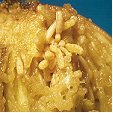 Onion Fly Maggot
Onion Fly Maggot
Life Cycle
This insect has a Holometabolous life cycle, ie. When metamorphosis is observed during the pupal stage.
It has up to two generations per year.
Period of Activity and Distribution of the Pest
This pest is found from tropical to temperate regions and is most active during warm weather. Adult flies are commonly seen hovering over garden beds that have had manure added.
Susceptible Plants
This pest attacks Allium species particularly onions. Beans, crucifers and cucurbits are also attacked.
Cynodon dactylon (Couch) turf grass is susceptible to the CouchTip Maggot (Delia urbana). The eggs are deposited by the small fly and the larvae are tiny white maggots that eat the growing points of the grass. It is only a serious problem when there are large numbers of maggots.
Damage Caused
The larvae tunnels into the stem of the host then moves to the below ground parts. Bulbs and roots are hollowed out causing the plant to turn yellow, wilt and collapse. Infected plants generally lack vigour. These holes allow a secondary infection to enter the plant.
Cultural Control
Correct soil preparation reduces infestation. Avoid planting in soil that has uncomposted organic material in it, particularly when it is dug into the bed. Mulching should be carried out during mid summer or in mid winter when the adults are less active.
This pest is difficult to eradicate and in an enclosed environment sticky fly paper can reduce numbers.
Biological control
There is no effective biological control.
Chemical control
The soil may be treated with primiphosmethyl to aid in control.
Note
Always read the label for registration details and direction of use prior to application of any chemicals.
Note: Plants affected by this pest are Deer Resistant plants not the susceptible plants.
PEST
NAME
Deer
Cervus species
ORDER
Artiodactyla
FAMILY
Cervidae

Description of the Pest
There are two species of the deer in North America, the Whitetail (Odocoileus virginianus) and the Mule deer (Odocoileus hemionus) with several regional variations such as the Pacific coastal Blacktail (O.h. columbianus) which is regarded as a sub-species of the Mule deer.
The Whitetail on average grows to 112 cm (44in) tall and 180 mm (70 in) long and weigh 68 kgs (150lbs). The fir colour varies according to its environment but generally it is reddish-brown during summer and grey-brown in winter with a pure white underside on its tail. When the tail is erect it is known as the "white flag". Its antlers consist of two main beams from which the points emerge.
The Mule deer grow to 105 cm (42 in) tall and are up to 200 cm (80 in) long with the adult buck weighing up to 137 kgs (300 lbs) and the does up to 80 kgs (175 lbs). The fir is generally tawny brown during summer and during winter it has a heaver grey-brown to blue-grey coat with a small white tail that is tipped in black. The other distinguishing features are its ears that are up to 300 mm (1 ft) long (mule-like) and its antlers, with the two beams that are forked into smaller beams, which inturn fork again and again.
The Blacktail deer (Pacific coastal Blacktail) grows to 97 cm (38 in) tall and is up to 105 cm (60 in) long and weighs on average 73 kgs (160 lbs). The fir is generally tawny brown during summer and during winter it has a heaver grey-brown to blue-grey coat with a tail that is dark brown at the base then changing to black for 50% of its length. The antlers consist of two beams that are forked into smaller beams, which inturn fork again and again.
Appearance and Distribution of the Pest
The Whitetail deer are found throughout eastern United States, on the coast and inland but are not commonly seen in California, Utah or Nevada. They do not migrate but congregate together (yard up) during winter and feed in a part of their existing territory.
The Mule Deer are found in the western part of North America from South eastern Alaska to Mexico and from the Pacific coast to Texas. They migrate from highland mountain meadows to southern or lower snow free forested valleys during winter.
The Blacktail deer are found on the Pacific coast from Alaska to northern California. There is both resident and migratory Blacktails. The migratory Blacktails move southwards during late autumn at the first sigh of snow or heavy sustained rain and the resident Blacktails seek cover their existing territory amongst woodlands during the winter months.
Life Cycle
All Deer breed from autumn to early winter and the does give birth from late spring to early summer.
Period of Activity
Deer are most active from spring to autumn but can be troublesome during winter when the feed is scarce. In some regions urban landscapes become the major food source both in summer and winter.
Damage Caused
Browsing deer will feed on almost any plant and is most commonly noticeable during spring feeding on the new growth or twigs and stems leaving a shredded appearance. Deer also rub their antlers against trees damaging bark and snapping off small branches, this action also incurs damage under hoof as plants, lawns and garden structures are trampled on.
Susceptible Plants
Some plants are more palatable to deer but when a deer is hungry or during drought conditions there are no "Deer Proof" plants. There is a range of plants that have a bad taste and are not destroyed and are regarded as (deer resistant plants). Deer resistant plants are the plants that are attached to this file not the susceptible plants.
Cultural Control
There are many cultural controls that have been tried to move browsing deer such as frightening them with strobe lights, pyrotechnics or tethered savage dogs. These actions are only temporary and may cause more trouble as the stampeding animals move off. Fencing and netting can be an effective method of discouraging hungry deer from gardens but may be expensive on a large scale and require maintenance. There are several types of fences which include conventional 2.2m (8 ft) deer-proof woven wire fences or single-wire electric fences and slanted deer fences. Plant selection can also be effective, by using less desirable plants (deer resistant plants) as an outer border to the more desirable plant species and thus discouraging the deer to enter the garden. Hedges and windrows of less desirable thorny plants can also be a deterrent to browsing deer.
Chemical Control
There are two main types of repellents contact and area. Contact repellents are applied directly to the plants and deter deer with a bad taste or smell. They can be applied by rubbing or spraying on to the plants and commonly used in an egg mixture. The commercial products have proven to work better than home remedies which include soap or chilli mixtures and hanging bags of human hair.
Area repellents rely on an offensive odour and are placed around areas that are frequently visited.
Contact your local distributor for available types and application.
DISEASE
NAME
Sclerotinia Rot, Crown Rot
Sclerotinia species
Description
A fungal problem that attacks plant parts causing them to collapse and rot, including flower, leaf and stems.
Symptoms
This fungus attacks all the above ground parts of the plant but commonly infects the stem at the base, where it forms a soft, light brown watery rot that spreads rapidly. Under humid conditions the rotted areas forms white fluffy mycelium on which black sclerotia up to 10mm long develop. These sclerotia also form within the stem in affected areas. When leaves are infected the tissue may brown and dry out, especially during arid conditions. The resulting affect of infection is the death of the plant.
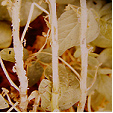
Image by B. Sonsie
Crown Rot (Sclerotium delphinii) causes leaves to turn yellow then become dry, and blossoms to wilt eventually killing the entire plant. It is found on Scilla, Viola and Delphinium species.
Flower Blight (Sclerotinia camelliae) infects flowers either by attacking the top of the petals forming brown specks or at the base of the flower where the petals turn brown then fall with out any sign of rot. The fungus develops on the fallen petals where microconidia are produced under moist conditions and eventually sclerotia appear. This form of the fungus can overwinter either above or below soil level until favourable conditions occur, then the spores are released and dispersed by wind.
Source and Dispersal
Sclerotia are found in the soil or on other infected plants and released spores are dispersed by wind.
Favoured Conditions
Prefers cool moist conditions with temperatures from 10º to 25ºC and is more common from autumn to spring when it is wet.
Affected Plants
A wide range of plants can be infected included French beans, peas, celery, cabbage, cauliflowers, carrot, parsnip, dahlia stocks, primula and many weeds.
Actinotus, Dampiera, Westringa species and Helichrysum bracteatum are infected by the Crown Rot (Sclerotinia rolfsii). Basial rot of the plant with cottony fungal growth and is associated with root congestion. Certain species of orchid may also be attacked.
Allium species are infected by the White rot (Sclerotium cepivorum) which is a major fungal disease of plants.
The bulb rot and are covered in mycelial which develop small black sclerotia (fruiting bodies) and infected plants may fail to produce flowering stem with the leaves become covered in a white mould, turning yellow then dieing off. It is commonly transmitted by infected seedlings and diseased plants should be burnt. Avoid re-planting Allium species in the infected soil where the spores overwinter. Soil may be infected for several years.
Antirrhinum, Aquilegia, Lobularia and Mathiola species are attacked by the Stem Rot (Sclerotinia sclerotiorum ) which infects the stigma travelling downwards through the flower into the stem where water soaked areas appear causing it to collapse. The flowers become pale and the entire plant may collapse. On inspection flat sclerotia may be seen in the stem.
Camellia species may be infected by Flower Blight (Sclerotinia camelliae) which causes blooms to fall and Stem Rot (Sclerotinia sclerotiorum).
Hyacinthus species can be infected by the fungus Black Slime (Sclerotinia bulborum) that causes the leaves to turn yellow then fall and bulbs to disintegrate.
Iris species are infected by the fungus Rhizome Rot (Botryotinia convoluta) that infects the rhizomes and forms black sclerotia, and is normally found on dieing plants during spring.
Turf Grass in warm climates is susceptible to Rolf's Disease (Sclerotinia rolfsii). The fungus infects the turf causing isolated dead patches up to 450mm across from spring to summer. As it progresses the dead patches increase in size and the white cotton-like mycelium can be seen in the underlying soil. It is not regarded as a major problem, with minor attacks on Cynodon dactylon (Couch) and Zoysia species.
Non-chemical Control
Initially remove and destroy any infected plants, when replanting, avoid using susceptible crops for 3 years. Space the plants to reduce the humidity and airflow and cultivate the soil to increase the drainage. Remove weed growth and leaf or flower litter from around the base of the plants to reduce the development of spores
Turf Grass culture such as aerating soil and maintaining a neutral pH helps prevent infection of Rolf's Disease.
Chemical Control
No suitable fungicides available, though drenching or spraying the soil with the fungicide dichloran helps control it.
DISEASE
NAME
Downy Mildew (General)
Various Downy Mildew Species
Description
Generally Downy Mildew may occur as a result of several fungal species, but have simular symptoms. The fungus is normally host specific.
Symptoms
The upper leaf forms yellowish, green or translucent patches that become enlarged and eventually the leaf turns yellowish-brown, wilts and dies. It can extend down the petioles onto the plant causing it to collapse and on the underside of the patches downy spores form, these may be grey to mauve or brown to purplish.
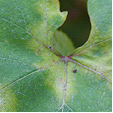
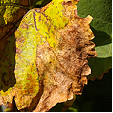
The Downy Mildew (Plasmopara halstedii) forms pale green spots on the upper surface of the leaves with corresponding white felty areas on the underside. The affected leaves contract, turn brown and die; commonly found on Senecio species.
Downy Mildew in Rose (Peronospora sparsa). Angular purplish to dark brown spots or areas develop on the upper leaf surface and under humid conditions, the underside of these areas develop fury fruiting bodies. Young and heavily infected leaves turn brown and fall. The flowers stalks and stems are also attacked with purplish blotches or streaks that may cause them to split. Young growth that is infected dies off and if the flowers are affected in bud blooms become deformed when open.
The spores overwinter on infected plants and fallen leaves and are dispersed by wind infecting new growth during spring.
Downy Mildew in Stocks (Peronospora parasitica). The upper leaf forms yellowish green patches that become enlarged and eventually the leaf becomes yellow, then wilts and dies. It also infects the stems and on the underside of the leaves patches downy grey to mauve-white pustules form where the spores are arranged in rows. This fungus is soil born and commonly dispersed by infected plants.
Source and Dispersal
It is normally found or dispersed on other infected plants. The spores are also spread by wind but are unable to germinate in dry conditions, requiring moisture on the leaf and a humid environment to grow.
Favoured Conditions
It prefers warm humid days with cool nights and spread quickly in closely planted seedlings or plants.
Affected Plants
A wide range of vegetables, annuals, perennials and shrubs are affected. Plants such as stocks and seedlings are at most risk commonly causing the plant to collapse and die.
Aster species are infected by the downy mildew (Basidiophora entospora).
Mathiola incana and Arabis species is infected by (Peronospora parasitica) causing stunting with downy mold on the underside of the leaves. Seedlings are at most risk commonly causing the plants to collapse and die.
Rudbeckia species are infected by the downy mildew (Plasmopara halstedii) causing yellowing of the foliage, wilting and in some cases death of the plant.
Turf Grasses are susceptible to the downy mildew (Scleropthora macrospore), which may not appear downy on the leaves but leaves affected are stunted, thickened or become broad and only under severe cases small yellow patches up to 100mm wide appear in the turf.
Veronica species are infected by the downy mildew (Peronospora grisea). Symptoms include leaves form pale spots on the upper surface while greyish mildew forms correspondingly on the underside.
Viola species ate infected with (Bremiella megasperma) which forms irregular greyish spots on the upper surface and felt-like growth on the underside.
Non-chemical Control
Infected plants must be removed and destroyed and avoid over planting seedbeds. Avoid watering from above or over watering to reduce humidity. When planting out space the plants to allow good air circulation as a dry atmosphere halts or reduces the infection. Select resistant plant species when planting.
Improve drainage and aeration of the soil in affected Turf grasses and avoid overwatering.
Chemical Control
With seedlings drench the soil with a systemic root absorbing fungicide such as furalaxy. Plants can be sprayed with a protectant fungicide such as copper oxychloride or zineb if the weather conditions are favourable for fungal attack. Be certain to thoroughly cover the under side of the leaves.
Average Lowest Temperature : -10º C 14º F
USDA : 4, 5, 6, 7, 8, 9
This USDA (United States Department of Agriculture) hardiness zone chart can be used to indicate a plant’s ability to withstand average minimum temperatures. However, other factors such as soil type, pH, and moisture, drainage, humidity and exposure to sun and wind will also have a direct effect on your plant’s survival. Use this chart only as a guide, always keep the other factors in mind when deciding where, when and what to plant.
A plant's individual USDA zone can be found in the Plant Overview.
Region of origin
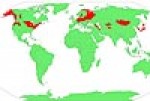
Europe, Asia, North America
Climate Description
Cool to Cold
These zones have low winter temperatures with moderate humidity and moderate summer temperatures.
Frosts and snow are severe. Droughts rarely occur and wind is cold.
Plant growth
Endemic native and exotic cool climate plants grow well within these zones.
| Dictionary | Growth Habit |
| Leaf Type | Botanic Flower Description |
| Leaf Shape | Flower Inflorescence |
| Leaf Arrangement | Fruit Type |
| Leaf Margin | Bark Type |
| Leaf Apex And Bases | Flower Description |